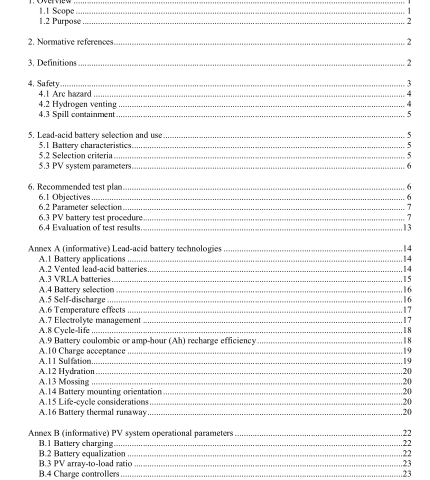IEEE 1361-2014 pdf download.IEEE Guide for Selecting, Charging, Testing, and Evaluating Lead-Acid Batteries Used in Stand-Alone Photovoltaic (PV) Systems
4. Safety
Installation of batteries under test should be in accordance with procedures and safety guidelines outlined in IEEE Std 450™ [B3], IEEE Std 1188™ [B7], and IEEE Std 937™ [B5]. At least the following should be considered mandatory for personnel safety: goggles for eye protection, acid resistant gloves, eyewash stations (portable or stationary), electrolyte neutralizing solutions, protective clothing, and a class C fire extinguisher.
Select a solution (or powder) that neutralizes the 20%-30% sulfuric-acid solution (standard electrolyte). Sodium bicarbonate (baking soda) works well to neutralize electrolyte spills. Neutralizing electrolyte spills may subject the users to hazardous waste regulations. Contact the local hazardous waste office for guidance.
4.1 Arc hazard
Batteries used in low-voltage small stand-alone PV systems can be a source of electric arc hazards. Care should be taken to prevent accidentally shorting the positive and negative terminals, or the positive terminal or negative terminal and any grounded surface of a cell or battery when using non-insulated metallic tools or other metallic objects, such as jewelry. In most cases, battery short-circuit currents can exceed 1000 A. Special electrically insulated tools should be used to enhance safety. In addition, it is prudent to fuse and properly size all conductors in the system to prevent damage to wiring and test equipment in the event of a short circuit or equipment malfunction. Guidance on arc hazards can be found in NFPA 70E [B14]. NFPA 70E cites additional arc hazard references.
4.2 Hydrogen venting
Vented lead-acid batteries release hydrogen and oxygen gas as a result of the electrolysis of water. The electrolysis of water is a consequence of the battery charging process and begins to occurs after the battery is fully charged [B10]. As the charge voltage increases, the electrolysis also increases accordingly. To protect against igniting the potentially flammable and/or explosive hydrogen and oxygen mixture inside the vented battery, the National Electrical Code®, Section 480.10 [B13] requires that battery installations use flame-arrester vent caps.
Flame-arrester vent caps for vented batteries typically consist of a micro-porous ceramic or plastic foam to prevent a flame or other external ignition source from igniting the hydrogen inside the cell. Valve-regulated lead-acid (VRLA) batteries under normal operation vent only very small quantities of hydrogen, thus room ventilation is generally more than adequate for hydrogen protection as long as charge voltage is controlled. If VRLA battery charge voltage is uncontrolled and reaches excessive levels, then the quantity of hydrogen released can approach that of vented batteries.
In applications where VRLA batteries are placed in enclosures restricting air circulation, additional ventilation may be required. The maximum hydrogen evolution rate, as found in IEEE Std 484™ [B4], occurs when the battery is fully charged at the maximum charge current. To calculate maximum hydrogen production and thus required room air ventilation, is suggested in Equation (1).
Where: P H = production of hydrogen
N = the total number of cells in the battery
I = maximum current (once the battery is fully charged) in amperes per cell at 25 °C
Once the volume of hydrogen production is known, the percent of hydrogen buildup in the battery room can be calculated by using the room air volume and the room air exchange rate. The battery room should be free of areas that might collect pockets of hydrogen gas. Most system designers require hydrogen levels below 1% or 2%, since the lower flammable limit is 4%. A battery room that meets the above requirements for ventilation should not be considered a classified (hazardous) location. Refer to the NEC [B13] for Hydrogen hazard classification. Additional safety guidelines may be found in IEEE Std 450™ [B3], IEEE Std 484™ [B4], IEEE Std 1188™ [B7], IEEE Std 1635™/ASHRAE 21 [B10], and NFPA 70E [B14].IEEE 1361 pdf download.IEEE 1361-2014 pdf download
IEEE 1361-2014 pdf download

Leave a Reply